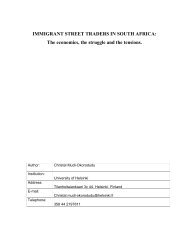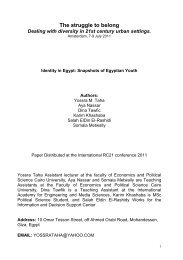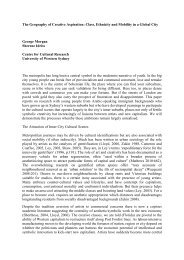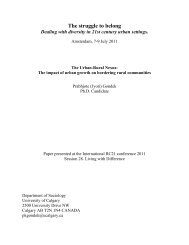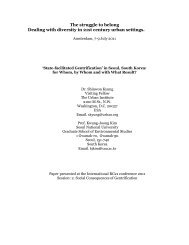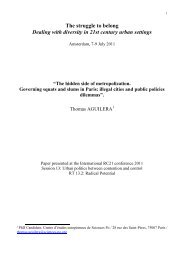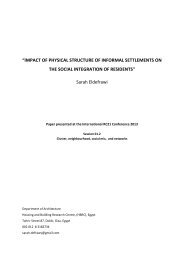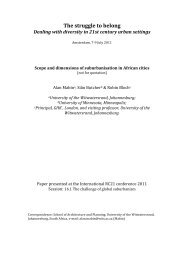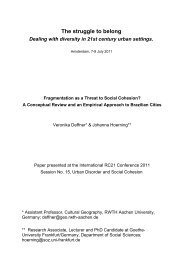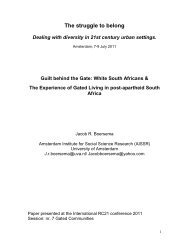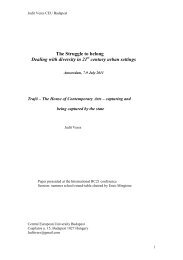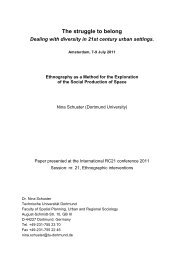Gentrification in the mill land areas of Mumbai city - RC21 ORG ...
Gentrification in the mill land areas of Mumbai city - RC21 ORG ...
Gentrification in the mill land areas of Mumbai city - RC21 ORG ...
Create successful ePaper yourself
Turn your PDF publications into a flip-book with our unique Google optimized e-Paper software.
The gentrification process <strong>in</strong> <strong>Mumbai</strong> has acquired prom<strong>in</strong>ent status only after <strong>the</strong> decl<strong>in</strong>e <strong>of</strong><br />
textile <strong>mill</strong>s which was thought to be its lifel<strong>in</strong>e. The huge area <strong>of</strong> Parel, Lower Parel,<br />
Ch<strong>in</strong>chpokli, Sewri, Dadar, and Elph<strong>in</strong>ston known as Girangoan or <strong>the</strong> <strong>land</strong> <strong>of</strong> <strong>the</strong> <strong>mill</strong>s<br />
possessed a historical significance from time immemorial with its <strong>mill</strong> and <strong>in</strong>digenous<br />
culture. It was considered to be <strong>the</strong> birth place <strong>of</strong> <strong>the</strong> work<strong>in</strong>g class and its culture <strong>in</strong> <strong>the</strong> <strong>city</strong>.<br />
The huge <strong>mill</strong> <strong>land</strong>s with magnificent <strong>mill</strong> structure, tall chimneys, <strong>the</strong> sounds <strong>of</strong> <strong>the</strong><br />
mach<strong>in</strong>es, sirens dur<strong>in</strong>g change <strong>of</strong> shifts, <strong>the</strong> chawls <strong>of</strong> workers, forms a milieu <strong>of</strong> <strong>the</strong> <strong>mill</strong>.<br />
However, with <strong>the</strong> advent <strong>of</strong> neoliberal policies <strong>the</strong> process <strong>of</strong> de<strong>in</strong>dustrialisation has<br />
contributed to <strong>the</strong> closure <strong>of</strong> <strong>the</strong> <strong>mill</strong>s one after <strong>the</strong> o<strong>the</strong>r, with <strong>the</strong> longest textile <strong>mill</strong> strike<br />
dur<strong>in</strong>g 80s that lasted for two years (Krishnan, 2000; D’Monte, 2002). Once, honoured as <strong>the</strong><br />
heritage <strong>of</strong> Bombay, textile <strong>mill</strong>s have fallen <strong>in</strong>to a matter <strong>of</strong> disgrace. Gradually, <strong>the</strong> huge<br />
abandoned <strong>land</strong>mass <strong>in</strong> <strong>the</strong> central part <strong>of</strong> <strong>the</strong> <strong>city</strong> became a focal po<strong>in</strong>t <strong>of</strong> attraction for <strong>the</strong><br />
builders and <strong>the</strong> <strong>city</strong> built up area started gentrify<strong>in</strong>g from <strong>the</strong> <strong>land</strong> <strong>of</strong> <strong>mill</strong>s to malls and<br />
towers. New age <strong>of</strong> modern constructions began to occupy <strong>the</strong> old <strong>land</strong> <strong>of</strong> <strong>mill</strong> and with<strong>in</strong> a<br />
span <strong>of</strong> few years what we witness is wholesale deconstruction <strong>of</strong> <strong>the</strong> structure or piecemeal<br />
renovation, that resulted <strong>the</strong> <strong>in</strong>dustrial <strong>land</strong> to get transformed <strong>in</strong>to <strong>the</strong> <strong>land</strong> <strong>of</strong> service sectors<br />
by br<strong>in</strong>g<strong>in</strong>g up new glass façade <strong>of</strong>fices, high end service sectors, enterta<strong>in</strong>ment and new<br />
generation creative <strong>in</strong>dustries. The cont<strong>in</strong>uous speculation <strong>of</strong> <strong>land</strong> value and its astronomical<br />
growth on one hand, with <strong>the</strong> Rent control act application on <strong>the</strong> older chawls <strong>in</strong> <strong>the</strong> locality,<br />
restrict<strong>in</strong>g it to a m<strong>in</strong>imum rent br<strong>in</strong>g<strong>in</strong>g <strong>in</strong> a locational advantage to <strong>the</strong> orig<strong>in</strong>al <strong>in</strong>habitants a<br />
greater barga<strong>in</strong><strong>in</strong>g power. Similarly, <strong>the</strong> newly rich migrant population from all over <strong>the</strong><br />
world found it easy to settle at <strong>the</strong> central location, consequently transform<strong>in</strong>g <strong>mill</strong> <strong>land</strong>s <strong>in</strong>to<br />
<strong>the</strong> <strong>land</strong> <strong>of</strong> transnational elites or ‘transnational capitalist classes’ (R<strong>of</strong>e, 2003) as cited by<br />
Harris (2008:2409). Frequent formation <strong>of</strong> gated communities is produc<strong>in</strong>g an <strong>in</strong>visible wall<br />
mak<strong>in</strong>g <strong>the</strong> locality a <strong>land</strong> <strong>of</strong> contrast. The huge residential towers are juxtaposed to <strong>the</strong> age<br />
old dilapidated chawls <strong>in</strong> <strong>the</strong> vic<strong>in</strong>ity that made <strong>the</strong> built up area <strong>in</strong>to a <strong>land</strong> <strong>of</strong> contestation<br />
where struggles and negotiations become a way <strong>of</strong> life. Therefore, as <strong>the</strong> <strong>city</strong> built up area<br />
transforms it leads to <strong>the</strong> transformation <strong>of</strong> socio-cultural political system and structure with<br />
reconfiguration <strong>of</strong> <strong>the</strong> social space.<br />
Objectives <strong>of</strong> <strong>the</strong> paper<br />
This paper is an attempt to br<strong>in</strong>g out <strong>the</strong> <strong>in</strong>ternal conflict and contestations and <strong>the</strong> daily<br />
negotiation with everyday life that occur <strong>in</strong> <strong>the</strong> neighbourhood <strong>of</strong> Sitaram Yadav Marg when<br />
gentrification has touched <strong>the</strong> area. The paper also looks <strong>in</strong>to <strong>the</strong> process <strong>of</strong> formation <strong>of</strong> <strong>the</strong>



